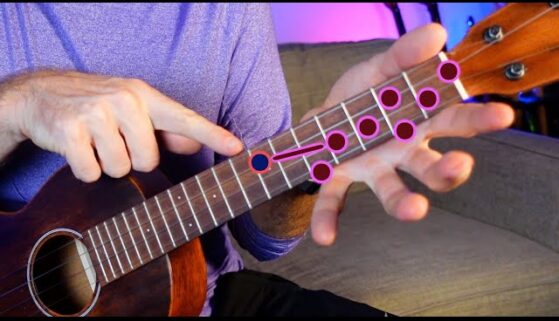Ukulele Scales and How to Use Them in Your Playing
When most people think of the ukulele, they picture cheerful strumming on sunny afternoons or lighthearted sing-alongs with friends. And it’s true—the ukulele is wonderfully simple to pick up and play. But beneath its playful sound lies a much deeper world of music waiting to be explored. Once you move beyond basic chords, you begin to realize that melodies, riffs, and solos add an entirely new dimension to your playing—and this is exactly where ukulele scales come in. They provide the roadmap to unlocking those melodies and give you the tools to move freely across the fretboard.
This is where scales step in. Far from being just dry exercises, scales are the foundation of nearly everything you hear in music. They give shape to melodies, structure to solos, and provide you with a roadmap across the fretboard. For ukulele players, scales aren’t just a theoretical concept—they’re a powerful tool to unlock creativity and freedom.
In this article, we’ll explore what scales are, why they matter, the most important scales for ukulele players, and most importantly, how you can start weaving them into your own music.

What Exactly Are Scales?
At their core, scales are simply a sequence of notes played in a specific order, either ascending or descending. Imagine them as a musical ladder, where each step is a note, and the distance between steps is either a whole step (two frets) or a half step (one fret).
While this might sound like abstract theory, scales are essentially the DNA of every song you know. They are what composers use to craft melodies, what improvisers rely on when creating solos, and what songwriters draw from when piecing together chord progressions.
On the ukulele, scales become especially exciting because the instrument’s compact size makes it easy to visualize patterns on the fretboard. Once you begin to see these patterns, you no longer feel “trapped” within chord shapes—you can move fluidly across the strings, picking out notes and creating new sounds.

Why Scales Matter for Ukulele Players
Many beginners skip scales, assuming they’re only for “serious” musicians. But even casual ukulele players can benefit tremendously from scale practice. Here’s why:
Improvisation: With scales under your fingers, you can start soloing over chord progressions, adding your own flair instead of sticking to strums.
Stronger Technique: Running through scales improves finger dexterity, accuracy, and overall control of your instrument.
Songwriting Tools: Scales provide the palette of notes from which you can craft riffs, hooks, and original melodies.
Ear Training: Regular practice helps your ear recognize intervals, making it easier to play by ear and stay in tune when singing.
Fretboard Confidence: Instead of relying on memorized chord shapes, you’ll gain a sense of freedom to move anywhere on the neck.
In short, scales are not about making practice boring—they’re about making playing limitless.

Essential Ukulele Scales
There are countless scales out there, but as a ukulele player, you don’t need to learn them all at once. Start with the most common and useful ones, then expand gradually as you grow more confident.
C Major Scale
The C major scale is often the first scale learned by ukulele players. It’s simple, bright, and forms the basis of many familiar tunes.
Notes: C – D – E – F – G – A – B – C
Pattern (on C string, open position): 0 – 2 – 4 – 5 – 7 – 9 – 11 – 12
This scale introduces you to the natural notes with no sharps or flats, making it perfect for practice. Play it slowly at first, then gradually pick up speed.
A Minor Scale
Every major scale has a “relative minor,” and for C major, that’s A minor. The notes are identical, but the tonal center shifts, giving the scale a darker, more emotional quality.
Notes: A – B – C – D – E – F – G – A
This is excellent for when you want your music to feel deeper and more soulful, rather than bright and cheerful.
Pentatonic Scales
If you only learn one type of scale beyond the basics, let it be the pentatonic. The name means “five-note scale,” and these scales are widely used across nearly every genre of music.
C Major Pentatonic: C – D – E – G – A
A Minor Pentatonic: A – C – D – E – G
The beauty of pentatonics is that you can almost never hit a “wrong” note. That’s why they’re a favorite for improvisation—they just sound good no matter how you use them.

Blues Scale
For that jazzy, expressive flavor, the blues scale is your best friend. It adds one extra “blue” note to the pentatonic, giving your solos grit and attitude.
A Minor Blues Scale: A – C – D – D# – E – G – A
If you love adding emotion or want to experiment with riffs that sound raw and soulful, this scale is a must.
Chromatic Scale
Unlike the others, the chromatic scale includes every single note in order, moving entirely by half steps.
Notes: C – C# – D – D# – E – F – F# – G – G# – A – A# – B – C
While you won’t use it directly for melodies, practicing the chromatic scale is excellent for finger strength, agility, and overall familiarity with the fretboard.

Practicing Scales the Right Way
Learning a scale is one thing—making it useful is another. Here are some tips for effective practice:
Start Slow – Focus on clarity. Every note should ring out cleanly.
Use a Metronome – Build rhythm discipline by playing in time.
Finger Efficiency – Assign one finger to each fret to avoid unnecessary stretching.
Explore the Neck – Don’t just stick to the open position; try scales higher up the fretboard.
Play Both Ways – Practice ascending and descending to build fluency.
With consistent practice, scales become second nature—and that’s when the creativity begins.

How to Actually Use Scales in Music
It’s one thing to practice scales as exercises, but how do you make them sound musical? Here are some practical ways to bring them into your playing:
1. Craft Melodies
Use the notes of a scale to build a simple melody over a chord progression. For example, if you’re playing C – G – Am – F, experiment with notes from the C major scale to create a vocal-like line.
2. Add Solos Between Chords
Instead of strumming nonstop, break up your playing by slipping in a quick scale run between chord changes. This makes your playing sound more professional and dynamic.
3. Write Riffs and Hooks
Some of the most memorable ukulele intros are born from pentatonic or blues scales. Try experimenting with short, repeating patterns to add personality to your songs.
4. Support Your Singing
If you sing while playing, scales can guide your voice. Running through scales helps you hit pitches more accurately and strengthens your vocal-ukulele coordination.
5. Improvise in Jams
Scales give you the confidence to join other musicians. With a pentatonic scale in your pocket, you can solo freely without clashing with the harmony.

Making Scales Sound Musical
Here’s the key: don’t treat scales like boring drills. The trick is to play with them creatively.
Change the rhythm: Don’t just play straight up and down—add syncopation.
Skip notes or repeat certain ones to create interest.
Use dynamics: some notes soft, others loud for contrast.
Blend scales with chords—strum, then pick a scale phrase.
Copy melodies from your favorite songs and trace how they fit within scales.
This transforms scales from mechanical practice into expressive playing.

Conclusion | Unlocking Freedom on the Ukulele
At first glance, scales may seem like “serious music theory,” far removed from the playful spirit of the ukulele. But in reality, they are the very tools that make playing more fun and creative. By learning even a handful of scales—the C major, A minor, pentatonic, and blues—you’ll gain the ability to write your own riffs, improvise with others, and truly understand the instrument in your hands.
The ukulele is more than just chords. With scales, you step into the world of melodies and solos, giving your playing a voice of its own. At The Mystic Keys, our Ukulele Lessons Online are designed to help you explore these scales in a simple, practical way—so you can build confidence, improve technique, and bring more creativity into your music.
So the next time you pick up your uke, don’t just strum—climb the ladder of scales and discover how limitless this little instrument can be.
For more information and exciting resources about learning music, visit our website at The Mystic Keys. For more music content and exciting offers follow us on
Facebook, Instagram, YouTube, LinkedIn, Twitter, Pinterest, and Threads,








